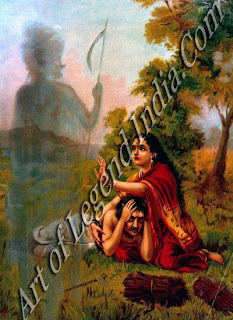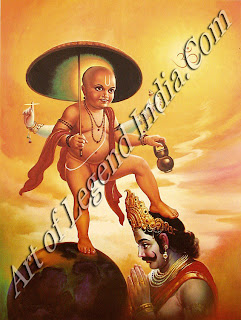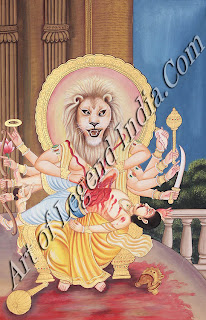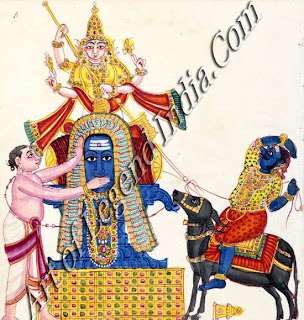The Puranas
After
the Srutis, Smritis and Itihasas, we have the fourth set of books, the Puranas.
There are 18 Puranas (of which the Bhagavata, Vishnu and Markandeya Puranas are
most popular) and 18 subsidiary or Upa Puranas. They are not meant for the
scholar, the intellectual or the spiritually evolved, but consist of tales
which convey the truths of the Vedas and Dharma Shastras in the form of short
stories. Told to children, to the simple villager and illiterate peasant, these
imaginative stories have formed the very basis of the religious education of
our ordinary people and help to teach them simple but fundamental truths of
religion and morality, of what is right and wrong in behaviour.
These
Puranas have been conveyed to successive generations by word of mouth, by
grandmothers to their grandchildren, by the village priest and by the wandering
minstrel. Walls of temples are covered with carvings of Puranic stories, a
visual method for educating the ordinary people.
For
example, to teach the people that God is everywhere and always comes to the
help of His devotee, the story of Prahlada is told Prahlada's father, the
demon-king Hiranyakashipu, tried his best to teach his son that there was none
more powerful than himself. But Prahlada was engrossed in his worship of the
Lord. Hiranyakashipu shouted at his son Do not pray to any but me,
Hiranyakashipu, the greatest of them all. I have a boon that neither man, beast
nor weapon can kill me. Nor can I die inside or outside a house, at day-time or
at night, on earth or in the sky. Where then is this God of whom you always
speak? Let Him dare appear before me!" But the child Prahlada insisted
that God was everywhere, outside and within us and all around us. "Is he
in this pillar? If so let him come out and fight me or I will kill you".
Saying this he struck the pillar.
 Out of
the pillar, which burst open, Vishnu appeared as Narasimha and destroyed evil
in the form of the demon. Neither man nor beast killed Hiranyakashipu, but
Vishnu did as Narasimha, half-man, half-lion. He killed him neither inside nor
outside the palace but on the door-step, on the threshold. He was killed not by
day or by night but at the hour of twilight. He did not kill him on the earth
or in the sky but did so by placing him on his lap.
Out of
the pillar, which burst open, Vishnu appeared as Narasimha and destroyed evil
in the form of the demon. Neither man nor beast killed Hiranyakashipu, but
Vishnu did as Narasimha, half-man, half-lion. He killed him neither inside nor
outside the palace but on the door-step, on the threshold. He was killed not by
day or by night but at the hour of twilight. He did not kill him on the earth
or in the sky but did so by placing him on his lap.
This
story taught that God is everywhere and finds some way to come to the aid of
those devotees who place their total faith in him.
The
Puranas taught the power of a chaste and good woman with stories like that of
Savitri. Born the daughter of the King of Madra, Savitri chose Satyavan, the
son of a deposed king, the blind Dyumatsena, as her husband. The couple lived
with Satyavan's parents in the forest. Savitri knew from Sage Narada himself
that Satyavan would die one year hence. On the day of his predicted death she
followed him into the forest when he went out to cut wood, all the time
worrying as to how she could prevent Death from taking him away. By the power
of her purity, Savitri saw Yama, the god of Death, take away Satyavan's prana
or breath of life, and followed him. She pleased him greatly by her words of
wisdom and got four boons given to her provided she did not ask for Satyavan's
life. As the fourth boon, she asked for a hundred sons and Yama granted her
wish.

She
then asked Yama how she, a chaste woman, could bear sons when her husband was
no longer alive. Not being able to go back on his word, which is considered one
of the greatest of wrongs, Yama gave back Satyavan alive to Savitri.
Ignorant
people often use the words `Sati Savitri' to describe a weak self-effacing
woman. On the contrary, Savitri was a strong and good woman who, by
determination, could even overcome the dictates of Destiny.
The
power of a good woman over gods and demons was an oft-repeated theme of the
Puranas.
Princess
Sukanya blinded an old sage, Rishi Chyavana, by accident. She then insisted on
marrying him and looking after him, thereby sacrificing her life of luxury as a
princess, and spending her hours caring for her old and blind husband. Once the
Ashwini twins, (who are celestial beings or Devas), saw the unparalleled beauty
of Sukanya and wished to test her steadfastness and loyalty to the blind sage.
They appeared in human form and asked her to marry one of them. When she
refused, they took a wager with her stating that they would transform her
husband into a young god to look exactly like themselves and if Sukanya did not
identify him, she would have to marry one of them.
 Su
kanya got the divine inspiration that only the one who blinked and whose feet
stood firmly on the ground was a mortal. By the power of her prayer she pointed
out her husband and showed that, before the strength of a good woman, even the
heavenly Ashwini twins were powerless. She is known as Sati Sukanya, Sati
meaning a pure and chaste woman, and has become a symbol of the power of a good
woman as, through her devotion, she restored the youth and eyesight of Sage
Chyavana.
Su
kanya got the divine inspiration that only the one who blinked and whose feet
stood firmly on the ground was a mortal. By the power of her prayer she pointed
out her husband and showed that, before the strength of a good woman, even the
heavenly Ashwini twins were powerless. She is known as Sati Sukanya, Sati
meaning a pure and chaste woman, and has become a symbol of the power of a good
woman as, through her devotion, she restored the youth and eyesight of Sage
Chyavana.
The
story of Dhruva, a young prince who, by his constancy and meditation won the
eternal blessings of Vishnu, was told in the Puranas to emphasise the
importance of prayer and meditation and their power to move God. By his
single-minded constancy and devotion to the Lord, Dhruva, after his death, was
transformed into the only star in the Universe that stays unmoved, the Pole Star,
known to this day as Dhruva in Hindu Astronomy.
The
story of Markandeya again showed how a young boy of sixteen conquered his
pre-destined Fate by his devotion to Shiva. Given only a 16-year span of life,
Markandeya did not allow Death to take him away on the due date but was given
the gift of immortality by Shiva by the strength of his bhakti or devotion.
Even
today when we bless a child when he sneezes, we say, "May you have the
life-span of Markandeya!". These Puranic stories are so strongly intertwined
in our daily lives and have been recounted as bed-time tales to Hindu children
from time immemorial.
To
teach children the importance of looking after their elders, we have the story
of the young boy, Shravana, who denied himself the joys of childhood and
boyhood while caring for his old and blind parents.
When
they wished to go on a pilgrimage to holy cities, he placed them in bamboo
baskets tied to a pole which he carried on his young shoulders and cheerfully
undertook the journey at great discomfort to himself.
The
strong family ties of our peasants, the care they lavish on their elders
(supporting them by working in cities, depriving themselves of even basic
necessities and sending home a major part of their earnings), are evidence of
the influence of such stories which deify filial ties.
 Another
interesting Puranic story is that of King Usinara of the Sibi clan who was a
great and just king whose generosity knew no bounds. Once when a dove rushed to
him for help to escape a hawk, the king gave it protection. The hawk protested
at being deprived of his rightful food.
Another
interesting Puranic story is that of King Usinara of the Sibi clan who was a
great and just king whose generosity knew no bounds. Once when a dove rushed to
him for help to escape a hawk, the king gave it protection. The hawk protested
at being deprived of his rightful food.
The
Sibi King offered his flesh as substitute, but however much he cut slices of
flesh from his body, the weight of the dove was greater. Usinara then offered
himself in entirety and balanced the scale.
Indra,
the king of the Devas (celestial beings or lesser gods) and Agni, the god of
Fire, had taken the form of the hawk and the dove only to test the generosity
and justice of the Sibi King, Usinara. The virtue of placing generosity over
and above one's life was taught by such stories.
Similarly,
to teach the importance of adhering to Truth, there are stories such as that of
King Harischandra. Wedded to Truth and true to a promise given by him, he gave
away his kingdom. To repay a sum of money promised to Vishwamitra, he sold his
beloved wife and son as slaves. Finally he sold himself to the keeper of a
cremation ground to pay the last instalment of the amount promised. However
Harischandra's sorrow knew no bounds when his wife Chandramati (known as
Taramati in some parts of the country), brought the dead body of their son,
Rohitsawa, for cremation.
When
Harischandra and his wife decided to fall into the pyre with their son, Indra,
the king of the Devas and Yama, the god of Death saved all three, and
acknowledged that Harischandra's adherence to Truth was a lesson even to the
gods.
The
importance of Truth and the inviolability of the spoken word are therefore
taught by many such stories from the Puranas.
Sudama
(also known as Kuchela) was an impoverished Brahmin with innumerable children.
He had been a childhood companion of Lord Krishna at Sage Sandeepani's
hermitage. One day, when there was not a morsel of food in the house, his wife
forced him to go to Krishna to get some help. The only gift he took to Krishna
were a few handfuls of beaten rice, but was shy of giving this poor gift to the
great Krishna, who, however; forced it out of his hand and ate a mouthful. When
Sudama returned without having asked Krishna for any favours, he found his hut
turned into a mansion and his family prosperous and happy.
The
story of Sudama impressed on the people that the poorest gift when given with
love is great enough to please God Himself. Also that true friendship cuts
through barriers of inequalities of position and wealth.
 It is
again in the Puranas that we read of the ten incarnations or Avatars of Lord
Vishnu on earth. These incarnations detail the help given by God during the
various stages of Man's evolution by His appearing on earth in different forms.
Surprisingly, many of these incarnations coincide with modern theories of
evolution.
It is
again in the Puranas that we read of the ten incarnations or Avatars of Lord
Vishnu on earth. These incarnations detail the help given by God during the
various stages of Man's evolution by His appearing on earth in different forms.
Surprisingly, many of these incarnations coincide with modern theories of
evolution.
These
Avatars teach mankind that God has re-established Dharma or righteous justice
and destroyed injustice from time to time by appearing on earth in various
incarnations. Starting with the Matsya (fish) Avatar, Lord Vishnu has appeared
as Kurma (tortoise), Varaha (boar), Narasimha (half man, half lion), Vamana
(the dwarf), Parasurama (the angry man), Rama (the perfect man), Krishna (the
divine statesman) and the Buddha (the compassionate man).
The
first Avatar, that of Matsya the fish, was taken by Vishnu at the end of the
last kalpa or age, when there was a deluge that destroyed the world that
existed then.
Choosing a sage, Rishi Satyavrata, Lord Vishnu commanded him to
gather together the seven great sages, samples of all animals, birds, plants, and
seeds, and wait in a boat. The gigantic golden fish then dragged the boat
through the turbulent oceans all through the long, long night of Brahma till
the deluge ended and Brahma created the present world. This Avatar is akin to
the story of Noah's Ark in the Old Testament, an evidence of the closeness in
many of the beliefs of ancient religions. Another version has it that a demon
once stole the four Vedas and hid them under the sea. Vishnu took the form of a
giant fish and retrieved these scriptures.

In the
Kurma Avatar, Vishnu took the form of a tortoise to help the Devas (heavenly
beings or lesser gods), to obtain the nectar of immortality which the Asuras
(demons) were also after. The Devas and Asuras churned the ocean to get this
nectar, using the giant snake, Vasuki, as the churning rope and Mount Mandara
as the churning rod. To prevent the mountain sinking into the ocean, Vishnu as
a giant tortoise supported the mountain under water until the nectar of
immortality emerged which Vishnu gave to the Devas alone.
At the
end of the deluge in the last kalpa or age, Bhoomi Devi (Mother Earth) sank
into the bottom of the ocean. Vishnu taking the form of a large boar, Varaha,
dived into the ocean and carried the goddess out of the waters supported by his
massive snout.
In
order to destroy Bali, king of the demons, Vishnu took the Avatar of a midget,
Vamana. He appeared during a huge yajna or sacrifice being conducted by the
king when the latter was arrogantly distributing gifts to all who asked for it
to show his power and wealth. Vamana asked for just three feet of land,
measured by his own small feet. With the first foot he covered the earth, with
the second, the heavens. When there was no place for the next foot of land,
Bali, to show that he never went back on his word, offered his head. Lord
Vishnu sent him to the nether regions but glorified this act unto eternity.
 When
the kings of the earth became autocratic and started to harm ordinary people
and sages in the forest, Vishnu took the Avatar of Parasurama and destroyed all
the Kshatriyas (princes) who were harassing the people.
When
the kings of the earth became autocratic and started to harm ordinary people
and sages in the forest, Vishnu took the Avatar of Parasurama and destroyed all
the Kshatriyas (princes) who were harassing the people.
When
priesthood became arrogant and priests used rituals to exploit the people,
Vishnu took the Avatar of the Buddha to purify Hindu practices of excessive
ritualism. He taught that all sorrow stemmed from attachments and desires and
advocated a Middle Path consisting of the eight-fold virtues of right views,
right resolve, right speech, right conduct, right livelihood, right effort,
right mindfulness and right meditation.
The
Avatars of Narasimha, Rama and Krishna have been explained earlier.
Hindus
believe that at the end of this age, or Kali Yuga, there will be a holocaust of
fire when the last Avatar, that of Kalki, will ride forth to save mankind and
re-establish Dharma, or righteousness.
To
summarise, we have covered four sets of books or scriptures so far. The first,
the Srutis or the Vedas are the very soul of Hinduism and are of divine origin.
They are eternal and without beginning or end. The Smritis or Dharma Shastras
are like the body, subject to decay and can be changed from time to time, from
age to age.
The
truths of the Srutis and Smritis are conveyed to the ordinary people through
the great Epics, which appeal to their hearts, and through the Puranas, which
appeal to their imagination.
Writer – Shakunthala Jagannathan
 Out of
the pillar, which burst open, Vishnu appeared as Narasimha and destroyed evil
in the form of the demon. Neither man nor beast killed Hiranyakashipu, but
Vishnu did as Narasimha, half-man, half-lion. He killed him neither inside nor
outside the palace but on the door-step, on the threshold. He was killed not by
day or by night but at the hour of twilight. He did not kill him on the earth
or in the sky but did so by placing him on his lap.
Out of
the pillar, which burst open, Vishnu appeared as Narasimha and destroyed evil
in the form of the demon. Neither man nor beast killed Hiranyakashipu, but
Vishnu did as Narasimha, half-man, half-lion. He killed him neither inside nor
outside the palace but on the door-step, on the threshold. He was killed not by
day or by night but at the hour of twilight. He did not kill him on the earth
or in the sky but did so by placing him on his lap. Su
kanya got the divine inspiration that only the one who blinked and whose feet
stood firmly on the ground was a mortal. By the power of her prayer she pointed
out her husband and showed that, before the strength of a good woman, even the
heavenly Ashwini twins were powerless. She is known as Sati Sukanya, Sati
meaning a pure and chaste woman, and has become a symbol of the power of a good
woman as, through her devotion, she restored the youth and eyesight of Sage
Chyavana.
Su
kanya got the divine inspiration that only the one who blinked and whose feet
stood firmly on the ground was a mortal. By the power of her prayer she pointed
out her husband and showed that, before the strength of a good woman, even the
heavenly Ashwini twins were powerless. She is known as Sati Sukanya, Sati
meaning a pure and chaste woman, and has become a symbol of the power of a good
woman as, through her devotion, she restored the youth and eyesight of Sage
Chyavana.  Another
interesting Puranic story is that of King Usinara of the Sibi clan who was a
great and just king whose generosity knew no bounds. Once when a dove rushed to
him for help to escape a hawk, the king gave it protection. The hawk protested
at being deprived of his rightful food.
Another
interesting Puranic story is that of King Usinara of the Sibi clan who was a
great and just king whose generosity knew no bounds. Once when a dove rushed to
him for help to escape a hawk, the king gave it protection. The hawk protested
at being deprived of his rightful food.  It is
again in the Puranas that we read of the ten incarnations or Avatars of Lord
Vishnu on earth. These incarnations detail the help given by God during the
various stages of Man's evolution by His appearing on earth in different forms.
Surprisingly, many of these incarnations coincide with modern theories of
evolution.
It is
again in the Puranas that we read of the ten incarnations or Avatars of Lord
Vishnu on earth. These incarnations detail the help given by God during the
various stages of Man's evolution by His appearing on earth in different forms.
Surprisingly, many of these incarnations coincide with modern theories of
evolution.  When
the kings of the earth became autocratic and started to harm ordinary people
and sages in the forest, Vishnu took the Avatar of Parasurama and destroyed all
the Kshatriyas (princes) who were harassing the people.
When
the kings of the earth became autocratic and started to harm ordinary people
and sages in the forest, Vishnu took the Avatar of Parasurama and destroyed all
the Kshatriyas (princes) who were harassing the people. 















0 Response to "Introduction to "Hindu Puranas" "
Post a Comment